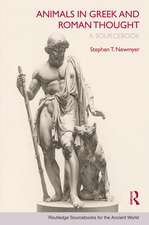The Aurelian Wall and the Refashioning of Imperial Rome, AD 271–855
Autor Hendrik W. Deyen Limba Engleză Paperback – 10 iun 2015
| Toate formatele și edițiile | Preț | Express |
|---|---|---|
| Paperback (1) | 325.38 lei 6-8 săpt. | |
| Cambridge University Press – 10 iun 2015 | 325.38 lei 6-8 săpt. | |
| Hardback (1) | 765.80 lei 6-8 săpt. | |
| Cambridge University Press – 6 apr 2011 | 765.80 lei 6-8 săpt. |
Preț: 325.38 lei
Nou
Puncte Express: 488
Preț estimativ în valută:
62.26€ • 65.01$ • 51.53£
62.26€ • 65.01$ • 51.53£
Carte tipărită la comandă
Livrare economică 04-18 aprilie
Preluare comenzi: 021 569.72.76
Specificații
ISBN-13: 9781107526532
ISBN-10: 1107526531
Pagini: 378
Ilustrații: 63 b/w illus.
Dimensiuni: 172 x 245 x 20 mm
Greutate: 0.6 kg
Editura: Cambridge University Press
Colecția Cambridge University Press
Locul publicării:New York, United States
ISBN-10: 1107526531
Pagini: 378
Ilustrații: 63 b/w illus.
Dimensiuni: 172 x 245 x 20 mm
Greutate: 0.6 kg
Editura: Cambridge University Press
Colecția Cambridge University Press
Locul publicării:New York, United States
Cuprins
Introduction; 1. Toward an architectural history of the Aurelian Wall, from its beginnings through the ninth century; 2. Planning, building, rebuilding, and maintenance: the logistical dynamics of a (nearly) interminable project; 3. Motives, meaning, and context: the Aurelian Wall and the late Roman state; 4. The city, the suburbs, and the wall: the rise of a topographical institution; 5. Sacred geography, interrupted; 6. The Wall and the 'Republic of St Peter'; Conclusion; Appendices.
Recenzii
'… a bold and adventurous book.' Scott G. Bruce, Bryn Mawr Classical Review
'Dey's book is compelling in that the author has brilliantly captured how the Aurelian wall transformed Rome in ways that make its tower-studded infrastructure of crucial significance to considerations of late antique urbanism. Dey deserves lavish praise for recognizing and amending for an earlier gap in scholarship. Dey has filled in the lacuna by presenting a grand narrative of how Aurelian's wall functioned as the linchpin in the reorganization of Rome's governance, ritual life, the construction industry and the system of food distribution. Readers, finally, should be delighted that, thanks to Dey's engaging prose and expansive scholarship, the important story about the late antique walls remaking Rome's interior has now received expert treatment.' Gregor Kalas, The Medieval Review
'Dey has truly produced an outstanding piece of cultural history. Throughout the book, he demonstrates a remarkable command of a broad range of sources as well as deep knowledge of the topography of ancient and medieval Rome. The study succeeds in showing not only how the Aurelian Wall transformed Rome and the lives of its inhabitants but also how it came to embody the essence of Christian and imperial Rome. The book will become essential reading not only for Roman and Late Antique scholars but also for historians of the Early Middle Ages and the medieval Papacy … The edition is of excellent quality. City plans and black-and-white photographs and drawings help navigate the argument. Five appendices present technical data and offer detailed treatment of aspects of Rome's topography. The book also features a useful index and extensive bibliography.' Carlos R. Galvao-Sobrinho, American Journal of Archaeology
'Dey's book is compelling in that the author has brilliantly captured how the Aurelian wall transformed Rome in ways that make its tower-studded infrastructure of crucial significance to considerations of late antique urbanism. Dey deserves lavish praise for recognizing and amending for an earlier gap in scholarship. Dey has filled in the lacuna by presenting a grand narrative of how Aurelian's wall functioned as the linchpin in the reorganization of Rome's governance, ritual life, the construction industry and the system of food distribution. Readers, finally, should be delighted that, thanks to Dey's engaging prose and expansive scholarship, the important story about the late antique walls remaking Rome's interior has now received expert treatment.' Gregor Kalas, The Medieval Review
'Dey has truly produced an outstanding piece of cultural history. Throughout the book, he demonstrates a remarkable command of a broad range of sources as well as deep knowledge of the topography of ancient and medieval Rome. The study succeeds in showing not only how the Aurelian Wall transformed Rome and the lives of its inhabitants but also how it came to embody the essence of Christian and imperial Rome. The book will become essential reading not only for Roman and Late Antique scholars but also for historians of the Early Middle Ages and the medieval Papacy … The edition is of excellent quality. City plans and black-and-white photographs and drawings help navigate the argument. Five appendices present technical data and offer detailed treatment of aspects of Rome's topography. The book also features a useful index and extensive bibliography.' Carlos R. Galvao-Sobrinho, American Journal of Archaeology
Notă biografică
Descriere
This book explores the relationship between the city of Rome and the Aurelian Wall during the six centuries following its construction.


















